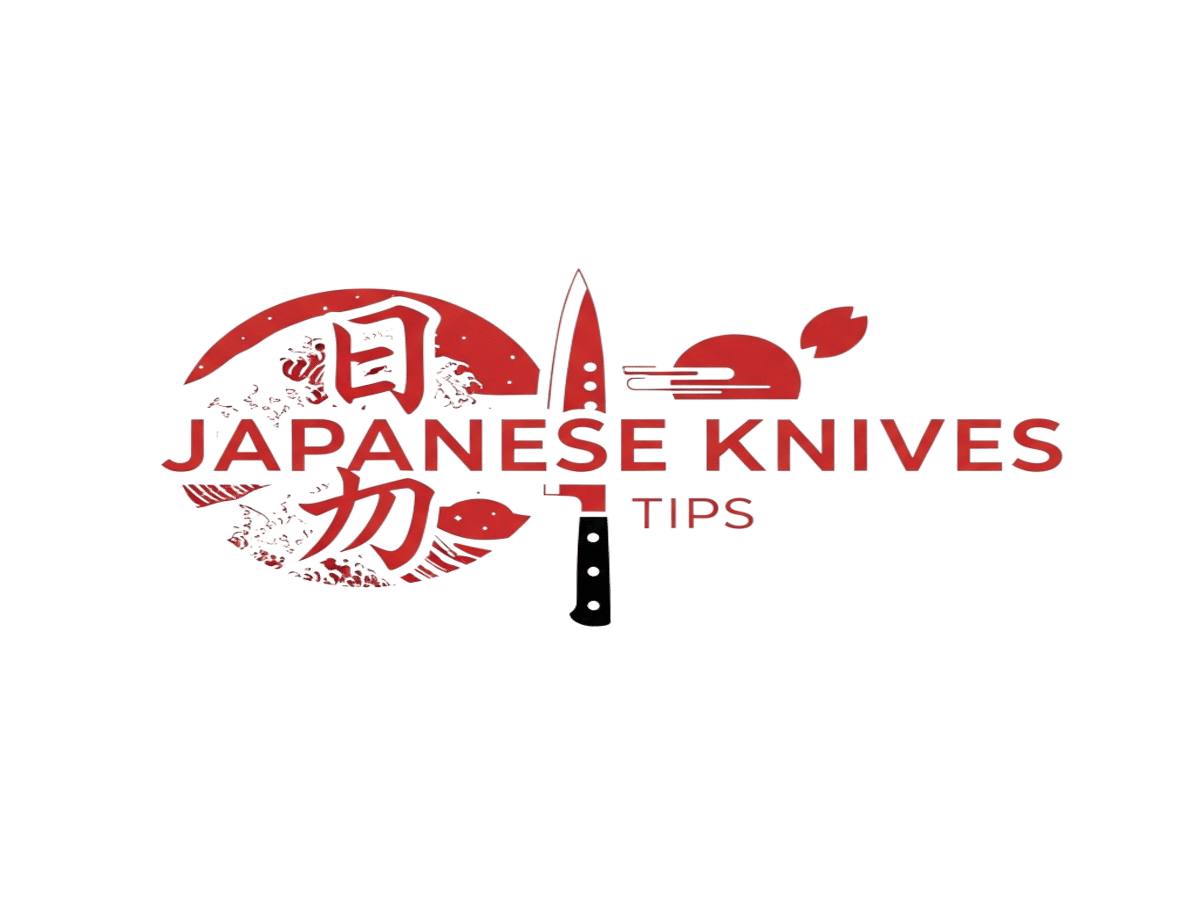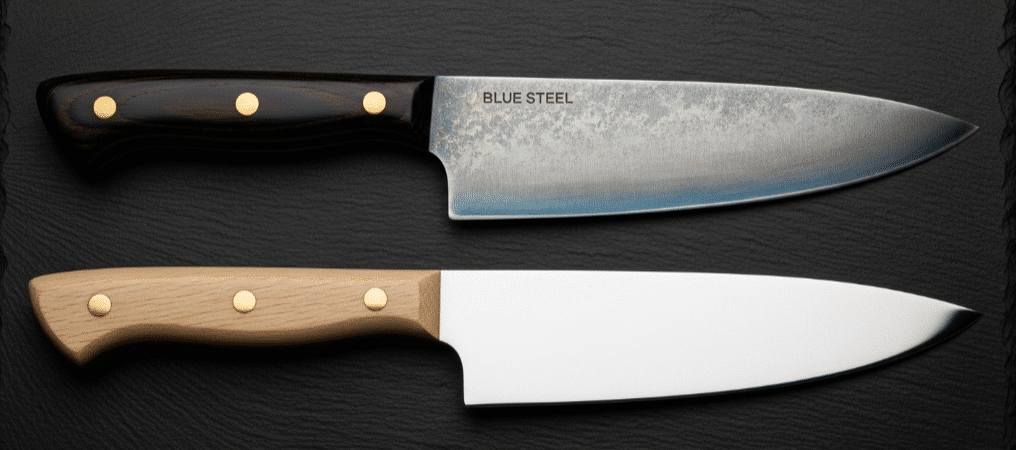If you’re into kitchen knives or thinking about buying a Japanese steel knife, you’ve probably heard about blue steel vs white steel. These two types of steel are popular for making sharp, durable blades, but they have some key differences that matter depending on how you plan to use your knife.
Blue and white steel are both high-carbon steels, and the choice between them depends on your performance preferences and how much maintenance you’re willing to do. Each is suited to different culinary styles and user needs.
I’ve spent a good amount of time learning about these steels, and I want to share what I’ve found in a clear, simple way. No fancy terms or confusing details—just straightforward info to help you understand why these steels are special and which might fit your needs better.
- What Are Blue Steel and White Steel?
- Why Does Carbon Content Matter?
- How Are These Steels Made?
- Paper Steel Production
- Heat Treatment: What’s the Deal?
- Cutting Edge and Sharpness
- Rust and Maintenance
- What About Aogami Super?
- Which Steel Should You Pick?
- Real Use Tips
- Why Japanese Steel?
- What About Laminated (San Mai) Blades?
- The Cost Factor
- Final Thoughts
- FAQs
What Are Blue Steel and White Steel?
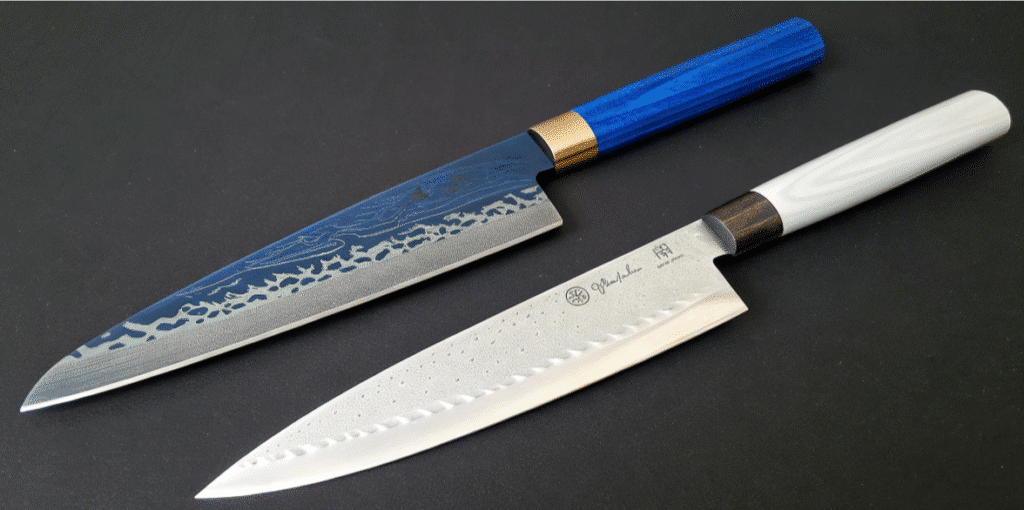
Both blue steel and white steel are types of high carbon steel made by Hitachi Metals in Japan, often called “paper steels” because of the traditional way they’re made. The “paper” part refers to how thin layers of steel are folded and hammered to create a strong, sharp blade. Blue steel contains specific alloys, such as chromium and tungsten, which enhance its toughness and durability compared to white steel.
Blue Steel (Aogami)
Blue steel, or Aogami, has added elements like chromium, tungsten, and vanadium. These extras make the steel tougher and help it maintain a sharper edge for a longer time. The name “blue paper steel” comes from the blue paper label used in the packaging.
White Steel (Shirogami)
White steel is purer, with fewer added elements. It’s known for taking an extremely sharp edge and being easier to sharpen. The “white paper steel” name comes from the white paper label on the steel packaging.
Why Does Carbon Content Matter?
Both steels have a high carbon content, which is important because carbon makes steel hard and able to hold a sharp cutting edge. Blue steel tends to have slightly more carbon and some extra alloying elements, which helps it resist wear and keep its edge longer.
White steel’s simpler makeup means it can get very sharp but might need sharpening more often. It’s great for people who want the finest edge possible and don’t mind a bit of extra care.
How Are These Steels Made?
Hitachi paper steels are made with careful folding and hammering techniques that create a laminated structure. This layering adds strength without making the blade too thick.
The manufacture of these steels follows strict standards and process guidelines to ensure quality and consistency.
The result is a thin, hard blade that’s sharp and durable but can be a bit brittle if not handled right.
Paper Steel Production
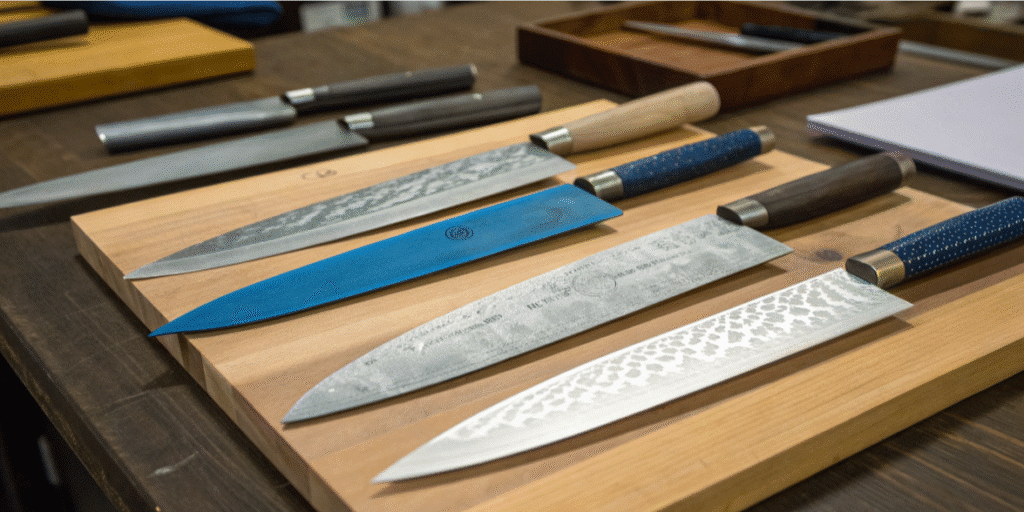
Paper steel production is a big deal in Japanese knife making.
It’s all about being precise.
Blue paper steel and white paper steel are the stars.
They give knives amazing edge retention.
And performance that’s hard to beat.
It starts simple. You need good iron. You need the right carbon content. But here’s where it gets interesting:
- Blue Paper Steel: Gets extra stuff added. Chromium, tungsten, vanadium. These make it tough and hold an edge forever.
- White Paper Steel: Stays pure. High carbon content. Super sharp edges. Easy to sharpen too.
Next comes the forging part. This is where the magic happens. The steel gets folded over and over. They call it pattern welding. It’s an old trick. Why do this? Simple. It kicks out the bad stuff. It mixes everything evenly. The result? Steel that’s the same all through. Harder edges. Stays sharp longer.
Heat treatment comes next. This step matters a lot. You heat the steel just right. Then you cool it fast. Real fast. This locks in what you want. Hardness and toughness. Hitachi Metals knows this stuff. They make blue paper steel, white paper steel, and Aogami Super. They give strict rules for this process. Get it right? You get high hardness. Great edge retention. Blades that handle tough kitchen work.
Many Japanese knives get a protective layer. It’s called cladding. Often comes with a kurouchi finish. This softer steel wraps around the hard core. Why? It stops rust. Keeps moisture and air away. Protects that sharp cutting edge. Plus it looks good. Traditional beauty.
Then comes sharpening and polishing. Skilled people do this part. They create a fine edge. Sharp and tough. This attention to detail matters. It’s why blue paper steel and white paper steel knives work so well. Chefs love them. Knife fans love them. People around the world appreciate this quality.
Paper steel production mixes science, art, and tradition. Every step counts. Picking the right carbon steels. Adding alloying elements. Forging. Heat treating. Finishing. All of it adds up. Beauty, durability, and performance. That’s what makes Japanese kitchen knives special. That’s why blue and white paper steel blades are so prized in knife making.
Heat Treatment: What’s the Deal?
The way these steels are heat treated affects how hard and tough the blade becomes. Both blue and white steels can reach high hardness levels, often above 60 on the Rockwell hardness scale. This means they’re hard blades that can hold a fine edge but may be more prone to chipping if used roughly.
Proper heat treatment balances hardness with toughness, so the blade won’t chip easily but will still stay sharp for a very long time.
Cutting Edge and Sharpness
If you want a knife with a very sharp edge, white steel is known for that. It’s easier to sharpen to a razor-thin edge, making it a favorite for precision cutting tasks like slicing fish or vegetables.
Blue steel also gets sharp but tends to hold its edge longer thanks to the extra alloying elements. This makes it a good choice if you want less frequent sharpening and a blade that’s a bit tougher.
Knives made from these steels are valued tools for chefs who seek exceptional sharpness and durability.
Rust and Maintenance
Both blue and white paper steels are carbon steel, so they can rust if you’re not careful. Blue steel has a bit better resistance to rust because of the added chromium, but neither is stainless steel.
To keep your knife in good shape, wipe it dry after use and avoid leaving it wet. Some people like the patina—a thin layer that forms over time and gives the blade a unique look. It’s not harmful and actually protects the steel a bit.
Before choosing a high-carbon steel knife, be prepared for the maintenance and care these steels require.
What About Aogami Super?
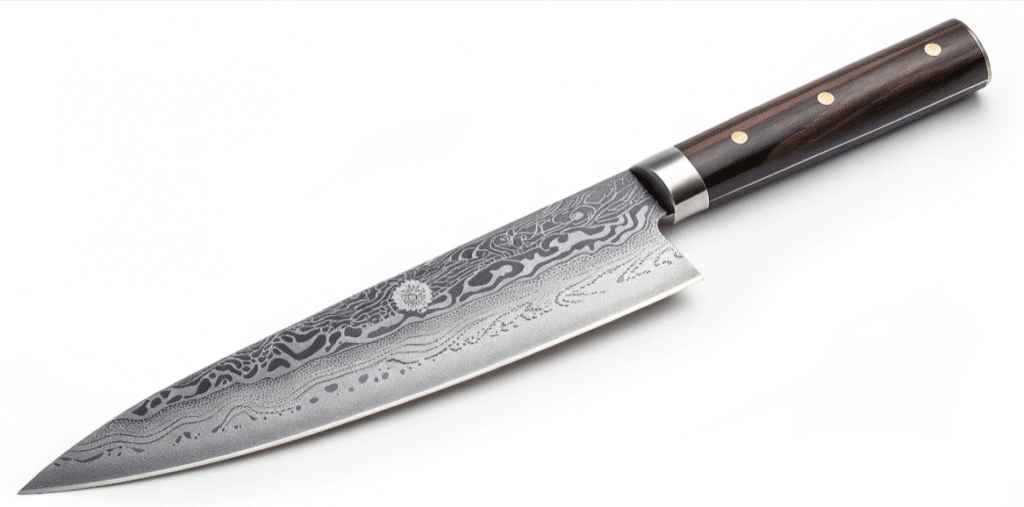
Aogami Super is a high-end version of blue steel with even more alloying elements like molybdenum and vanadium. This steel is harder and holds an edge longer but can be more expensive and a bit tougher to sharpen.
If you’re serious about knife making or want a professional-grade blade, Aogami Super is worth considering. For everyday use, regular blue or white steel knives usually do the job well.
A knife made from Aogami Super becomes a trusted tool in the kitchen, valued for its performance and longevity.
Which Steel Should You Pick?
Choosing between blue steel and white steel depends on what you want from your knife:
- If you want the sharpest edge and don’t mind sharpening more often, white steel is the way to go.
- If you prefer a blade that stays sharp longer and is a bit tougher, blue steel fits better.
- For those who want the best of the best and don’t mind the cost, Aogami Super offers top performance.
Real Use Tips
- Both steels tend to be thin and sharp, so handle with care to avoid chipping.
- Use a good sharpening stone, ideally in the 3000 to 6000 grit range, to keep the edge fine.
- Keep your knife dry and clean to prevent rust.
- If you’re new to carbon steel knives, start with white steel to get used to sharpening and maintenance before moving on to blue steel or Aogami Super.
- As you care for your carbon steel knife, you’ll eventually reach the point where a patina develops—this marks a transition in both the maintenance routine and the unique character of your knife.
Why Japanese Steel?
Japan has a long history of knife making, going back to samurai swords. The techniques and materials have been refined over centuries to create blades that balance sharpness, toughness, and beauty.
Hitachi metals, based in Japan, is famous for producing high-quality paper steels that many knife makers prefer. Their steels are known for excellent abrasion resistance and a fine edge that lasts.
What About Laminated (San Mai) Blades?
You might see knives described as “san mai” or laminated. This means the hard steel core (blue or white steel) is sandwiched between softer iron layers. This construction adds toughness and makes the blade less likely to chip while keeping a sharp cutting edge.
If you want a blade that balances sharpness with durability, a laminated knife is a great option.
The Cost Factor
Blue steel and white steel knives tend to cost more than typical stainless steel knives. The price reflects the quality of the steel, the heat treatment, and often the craftsmanship involved.
Aogami Super knives are usually at the higher end of the price range. But if you take care of your knife, it can last a very long time and offer excellent performance.
Final Thoughts
Blue steel vs white steel is a choice about what you value most in a knife. Both offer sharpness and durability far beyond regular stainless steel knives but require some extra care.
If you want a sharp, easy-to-sharpen blade, white steel is your friend. If you want a blade that holds its edge longer and is a little tougher, blue steel fits the bill.
Either way, these steels come from a rich tradition of Japanese knife making and offer a special experience for anyone who loves cooking or crafting knives.
If you’re ready to try one, just remember to keep it clean, dry, and sharp—and enjoy the difference a fine blade can make in the kitchen.
FAQs
What makes blue steel different from white steel?
Blue steel has extra metals like chromium and tungsten that help it stay sharp longer and resist wear better. White steel is purer with fewer added metals, so it gets sharper easier but needs sharpening more often. Blue steel is tougher, while white steel is great if you want a razor-sharp edge and don’t mind a bit more upkeep.
Can these steels rust if I don’t take care of them?
Yes, both blue and white steels can rust because they’re high carbon steels, not stainless. Blue steel handles rust a bit better thanks to chromium, but you still need to dry your knife after use and avoid leaving it wet. A little patina (a thin surface layer) can form over time, which isn’t bad and can even protect the blade a bit.
Should I start with white steel or blue steel if I’m new to carbon knives?
If you’re new, white steel might be easier to handle because it sharpens more easily. It’s a good way to learn how to care for carbon steel knives. Once you get used to sharpening and maintenance, you can move up to blue steel or even Aogami Super for longer edge retention and tougher blades.
